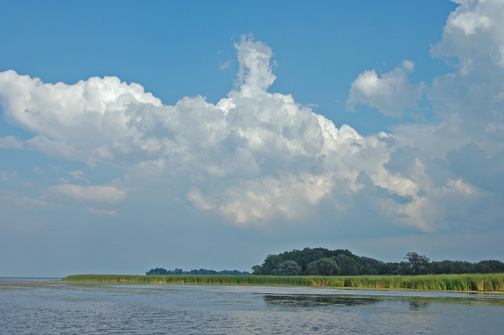
Braddock Bay is located on the shore of Lake Ontario in the town of Greece, NY and is part of the Rochester Embayment Great Lakes Area of Concern (AoC). Over the last one hundred years, due to wave driven erosion, there has been a gradual loss of the protective barrier beach as well as a loss of approximately 106 acres of wetlands. Also, since Lake Ontario water level regulation began in 1954, decreased fluctuations in water levels have resulted in the growth of a cattail monoculture and the loss of diverse habitat that once existed.
Study Overview:
The U.S. Army Corps of Engineers, Buffalo District has completed a feasibility study to identifying a plan for ecosystem restoration at Braddock Bay, Monroe County, NY. The goal of restoration is to improve habitat diversity of the existing emergent marsh currently dominated by cattail, and to reduce erosion of the existing emergent marsh. The black tern was chosen as a target species for habitat restoration, because it represents a historic habitat no longer present in the bay. This habitat, characterized by diverse aquatic vegetation zones, sedge grass meadows, and open water areas interspersed within a matrix of emergent marsh, will be significantly more ecologically diverse than the existing cattail dominated emergent wetland and would provide high quality habitat for many species of fish and wildlife including American mink and northern pike. The proposed project supports delisting of the Rochester Embayment Area of Concern (AOC) Beneficial Use Impairment (BUI) for loss of fish and wildlife habitat.
Contact Information
U.S. Army Corps of Engineers, Buffalo District
1776 Niagara Street
Buffalo, NY 14207
Telephone: 1-800-833-6390 (option 3)
Fax: 716-879-4434
Email: braddock.bay@usace.army.mil
1776 Niagara Street
Buffalo, NY 14207
Telephone: 1-800-833-6390 (option 3)
Fax: 716-879-4434
Email: braddock.bay@usace.army.mil
Written comments should reference Braddock Bay Application # 2015-00095 and can be mailed to:
US Army Corps of Engineers, Buffalo District
(Attn:) Kathleen Buckler
1776 Niagara Street
Buffalo, NY 14207
